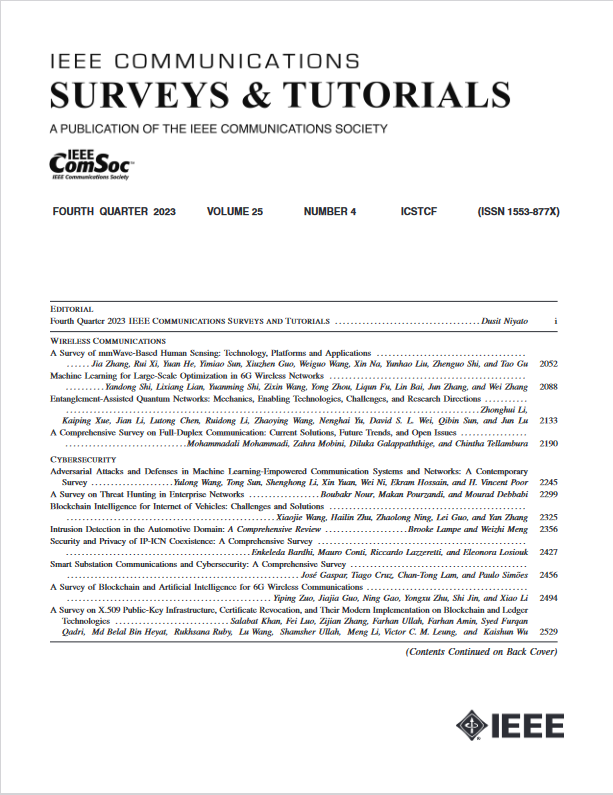A Comprehensive Survey on Full-Duplex Communication: Current Solutions, Future Trends, and Open Issues
IF 34.4
1区 计算机科学
Q1 COMPUTER SCIENCE, INFORMATION SYSTEMS
引用次数: 0
Abstract
Full-duplex (FD) communication is a potential game changer for future wireless networks. It allows for simultaneous transmit and receive operations over the same frequency band, a doubling of the spectral efficiency. FD can also be a catalyst for supercharging other existing/emerging wireless technologies, including cooperative and cognitive communications, cellular networks, multiple-input multiple-output (MIMO), massive MIMO, non-orthogonal multiple access (NOMA), millimeter-wave (mmWave) communications, unmanned aerial vehicle (UAV)-aided communication, backscatter communication (BackCom), and reconfigurable intelligent surfaces (RISs). These integrated technologies can further improve spectral efficiency, enhance security, reduce latency, and boost the energy efficiency of future wireless networks. A comprehensive survey of such integration has thus far been lacking. This paper fills that need. Specifically, we first discuss the fundamentals, highlighting the FD transceiver structure and the self-interference (SI) cancellation techniques. Next, we discuss the coexistence of FD with the above-mentioned wireless technologies. We also provide case studies for some of the integration scenarios mentioned above and future research directions for each case. We further address the potential research directions, open challenges, and applications for future FD-assisted wireless, including cell-free massive MIMO, mmWave communications, UAV, BackCom, and RISs. Finally, potential applications and developments of other miscellaneous technologies, such as mixed radio-frequency/free-space optical, visible light communication, dual-functional radar-communication, underwater wireless communication, multi-user ultra-reliable low-latency communications, vehicle-to-everything communications, rate splitting multiple access, integrated sensing and communication, and age of information, are also highlighted.全双工通信的综合调查:当前解决方案、未来趋势和开放问题
全双工(FD)通信是未来无线网络的潜在游戏规则改变者。它允许在同一频带上同时发送和接收操作,使频谱效率提高了一倍。FD还可以成为其他现有/新兴无线技术的催化剂,包括协作和认知通信、蜂窝网络、多输入多输出(MIMO)、大规模MIMO、非正交多址(NOMA)、毫米波(mmWave)通信、无人机辅助通信、反向散射通信(BackCom)和可重构智能表面(RISs)。这些集成技术可以进一步提高频谱效率,增强安全性,降低延迟,提高未来无线网络的能源效率。迄今为止还缺乏对这种一体化的全面调查。这篇论文填补了这一需求。具体来说,我们首先讨论了基本原理,重点介绍了FD收发器结构和自干扰(SI)消除技术。接下来,我们讨论了FD与上述无线技术的共存。我们还针对上述的一些集成场景提供了案例研究,并针对每个案例提出了未来的研究方向。我们进一步讨论了未来fd辅助无线的潜在研究方向、开放挑战和应用,包括无蜂窝大规模MIMO、毫米波通信、无人机、BackCom和RISs。最后,重点介绍了混合射频/自由空间光通信、可见光通信、双功能雷达通信、水下无线通信、多用户超可靠低延迟通信、车对万物通信、分速多址、集成传感与通信、信息时代等其他杂技术的潜在应用和发展。
本文章由计算机程序翻译,如有差异,请以英文原文为准。
求助全文
约1分钟内获得全文
求助全文
来源期刊

IEEE Communications Surveys and Tutorials
COMPUTER SCIENCE, INFORMATION SYSTEMS-TELECOMMUNICATIONS
CiteScore
80.20
自引率
2.50%
发文量
84
审稿时长
6 months
期刊介绍:
IEEE Communications Surveys & Tutorials is an online journal published by the IEEE Communications Society for tutorials and surveys covering all aspects of the communications field. Telecommunications technology is progressing at a rapid pace, and the IEEE Communications Society is committed to providing researchers and other professionals the information and tools to stay abreast. IEEE Communications Surveys and Tutorials focuses on integrating and adding understanding to the existing literature on communications, putting results in context. Whether searching for in-depth information about a familiar area or an introduction into a new area, IEEE Communications Surveys & Tutorials aims to be the premier source of peer-reviewed, comprehensive tutorials and surveys, and pointers to further sources. IEEE Communications Surveys & Tutorials publishes only articles exclusively written for IEEE Communications Surveys & Tutorials and go through a rigorous review process before their publication in the quarterly issues.
A tutorial article in the IEEE Communications Surveys & Tutorials should be designed to help the reader to become familiar with and learn something specific about a chosen topic. In contrast, the term survey, as applied here, is defined to mean a survey of the literature. A survey article in IEEE Communications Surveys & Tutorials should provide a comprehensive review of developments in a selected area, covering its development from its inception to its current state and beyond, and illustrating its development through liberal citations from the literature. Both tutorials and surveys should be tutorial in nature and should be written in a style comprehensible to readers outside the specialty of the article.
 求助内容:
求助内容: 应助结果提醒方式:
应助结果提醒方式:


